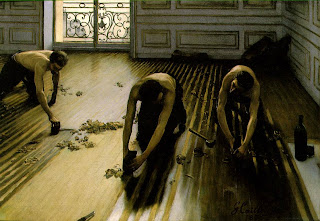Wednesday, October 14th, 2009
"The Challenge of the Avant-Garde" & Caillebotte
 I read The Challenge of the Avant-Garde (Paul Wood, ed., Yale University Press, 1999) several weeks ago for Heidenkind’s Art History Challenge. This is a textbook is comprised of case studies which discuss 19th-mid 20th century art, particularly in how art relates to the concept of “avant-garde.”
I read The Challenge of the Avant-Garde (Paul Wood, ed., Yale University Press, 1999) several weeks ago for Heidenkind’s Art History Challenge. This is a textbook is comprised of case studies which discuss 19th-mid 20th century art, particularly in how art relates to the concept of “avant-garde.”
Overall, I was quite pleased with this book. I’ll be using it for an upcoming class. I particularly like how the book examines how the term “avant-garde” and has changed over time. I did think that some parts of the book were confusing and biased (the authors seem extraordinarily bent on discussing art that has been underprivileged or underexposed in art historical studies), but I still would recommend it.
I was particularly interested in one case study that discussed Caillebotte and domestic space. I have always associated Caillebotte with modernity through his outdoor depictions of 19th century Parisian life, such as Paris Street: A Rainy Day (1877) and Pont de l’Europe (1876), I didn’t realize that Caillbotte also was interested in domestic space and interior settings. Two such paintings involve depictions of floorscrapers:
Fionna Barber (the author of this case study) emphasizes that these paintings are also depictions of modern Parisian life – the floorscrapers are modern individuals (wearing contemporary clothes) who are involved in their professional work.1 Understandably, this painting didn’t sit too well with critics at the time – largely because the image of the lower-class, “heroic worker” was clearly identified with paintings by the controversial artist Courbet (for an example, see Courbet’s Stonebreakers (by the way, did you know that the Stonebreakers was destroyed in 1945 during a bombing of Dresden? Isn’t that tragic?)).
If you want to learn more about Caillebotte and domestic space, I’d recommend that you pick up The Challenge of the Avant-Garde.
1 Paul Wood, ed., The Challenge of the Avant-Garde (New Haven: Yale University Press, 1999), 145.


This book sounds pretty freaking awesome. I love case studies of individual paintings, and surprisingly there really isn't much written about Caillebotte in comparison with some of the other Impressionists.
It's hard to imagine his paintings being "shocking" nowadays, isn't it?
I got both books. I am setting up a reading schedule for myself. Geeky I know, but I figure this would be the best way for me to stay dedicated to reading them and not allowing myself to be distracted by other books.
Oddly enough, while I was looking through the book this very painting caught my eye. I am excited to start my readings.
ooh, i'll have to read it! i remember those floorscraper paintings from our 19th century class – they seemed so out of the ordinary.
I LOVE the look of the 1875 version of Floorscrapers. This is what I love about your blog — you talk about things and artists that aren't (what I'd dare say)"mainstream" — at least in terms of the general population — and show how beautiful the art is. I'm pro the "famous" artists in history (and certainly Caillebotte is famous in the art world?) but it's been really cool for me to hear about people other than Picasso or something.
I hope you like the books, phin! I think a reading schedule is a good idea – I do the same thing all the time. 🙂